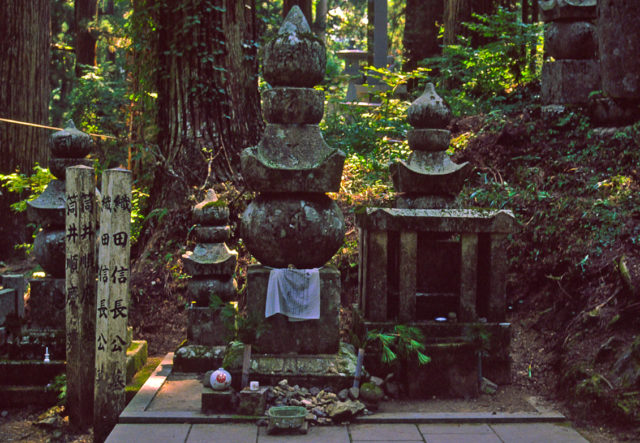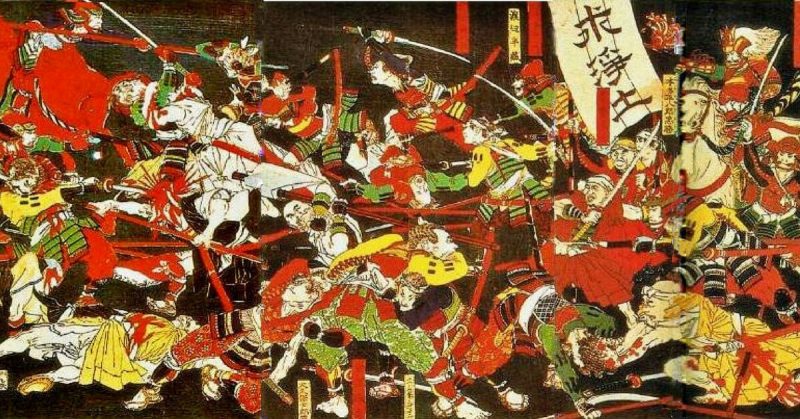For hundreds of years, noble samurai warriors dominated warfare in Japan. Here are some of their most significant battles.
Ichi-no-Tani, 1184
In 1184, the Taira clan were resisting the growing power of the Minamoto. The child emperor belonged to the Taira clan, but they were less militarily strong than their opponents.
The general Minamoto Yoshitsune led his troops in a daring attack on a Taira island base. While his forces attacked the palisades on two sides, he led a hand-picked band of samurai down steep paths to the rear. There they tried to cut off the defenders’ escape route.
The Taira kept their calm and fought bravely in hand-to-hand combat in the shallow waters around their boats. Many died in individual last stands, but most of the Taira escaped with the emperor.
Dan-no-Ura, 1185
The Minamoto finally pinned the Taira down the next year. A fierce battle took place in the straights of Dan-no-Ura, samurai fighting each other from ship to ship.
The Taira were utterly defeated. The emperor drowned, and a holy relic was lost forever beneath the waves. Survivors took part in one of the largest mass suicides in samurai history.
Third Battle of Uji, 1221
In 1221, the country was run by a regent on behalf of a weak Shogun. The ex-emperor Go-Toba tried to regain control on behalf of his son, rebelling against the officials who supposedly served him.
The rebellion ended on July 5. Go-Toba’s inexperienced and intimidated army retreated to the Uji river. Although they inflicted heavy casualties on their foes, they were defeated. The ex-emperor’s rebellion was at an end.
Siege of Chihaya, 1333
A century later, another revolution tried to restore imperial authority. It almost faltered following early defeats but was maintained by Kusunoki Masashige, a samurai of intense loyalty and skill from an obscure family.
Enemy forces surrounded the rebels in Chihaya Castle on Mount Kongo. There, Kusunoki used the terrain and his knack for innovation to his advantage. Enemy troops were lured into night attacks in narrow passes and picked off. Boulders were dropped on them from clifftops. Pit traps and felled trees obstructed their maneuvers.
Chihaya was never captured. Instead, it bogged down large forces in trying to take it; becoming an inspiration and rallying point for rebels fighting for the emperor.
Minatogawa, 1336
The Battle of Minatogawa was fought on the banks of the Minato River, where Kusunoki Masashige took a stand against the Ashikaga army. With the river at his back, he thought he had a strong defensive position. For a while, the battle could have gone either way, but enemy seaborne forces landed at his rear. A group of his supporters panicked and withdrew, leaving his army exposed. He was defeated.

Anegawa, 1570
The warlord Oda Nobunaga began the reunification of Japan after a period of intense violence and division. One of his most significant victories came at Anegawa, where he faced the threat of the Asai and Asakura clans.
Advancing from Kyoto, he threatened the fortress of Odani. The Asai and Asakura were forced to face him in battle. Fighting across the shallow Anegawa River, Nobunaga achieved a great victory with thousands of his enemies slain. With those clans destroyed, he moved on to the rest of Japan.
Nagashino, 1575
Another of Nobunaga’s victories, the Battle of Nagashino showed how the samurai declined as a fighting force.
Nobunaga, always ready to try new technology, embraced the power of gunpowder weapons. He equipped 3,000 of his soldiers with arquebuses and placed them behind field fortifications. When the samurai of the Takeda clan charged his line, they were cut down in a hail of gunfire. Nobunaga’s samurai then emerged to defeat the remnants at close quarters.
Sendaigawa, 1587
His successor, Hideyoshi continued Nobunaga’s work. Sendaigawa was the last major battle of Hideyoshi’s campaign against the Shimazu clan.
The battle was a highlight of the career of one of Hideyoshi’s best generals, Kato Kiyomasa. He began life as the son of a blacksmith, unlike most samurai who came from nobility. He fought valiantly in many battles, proving that courage, skill, and leadership were about more than breeding.
The Siege of Odawara, 1590
By 1590, only the Hojo clan held out against Hideyoshi. To finish them off, he advanced toward their greatest fortress at Odawara.
The Hojo knew if Odawara was destroyed then they were finished. They called in all their troops and followers from other castles to protect it. 50,000 men assembled to defend their position.
The attackers had even more. 200,000 men clogged the roads and surrounding countryside. Seeing an assault would be costly and futile, they spent most of the siege starving out the defenders. While they waited, the Samurai were entertained and grew vegetables until the occupants of the castle surrendered.
Sekigahara, 1600
Hideyoshi’s death created a power vacuum. The situation was resolved at Sekigahara in 1600.
The 58-year-old commander Tokugawa Ieyasu was a lifelong samurai who had survived a musket ball striking his armor earlier in life. He was a cunning tactician. By threatening his opponents’ lines of communication, he drew them into a fight on ground of his choosing. In a grueling battle in mud and rain, the largest armies ever assembled in Japan fought for control of the country. It was one of the last field battles between samurai and Ieyasu emerged victorious, becoming shogun.
Tenno-Ji, 1615
The final field battle between samurai took place outside the walls of Osaka in 1615. The great fortress had been under siege for months, as Ieyasu tried to finish off resistance by his enemies. Trickery eventually gave him an advantage and led to a huge battle outside its defenses. Ieyasu took part in the fighting and was wounded by a spear thrust. Despite his injury, he emerged triumphantly.
Source:
Stephen Turnbull (1987), Samurai Warriors
